 Technology peripherals
Technology peripherals
 AI
AI
 Introducing a large domestic open source MoE model, its performance is comparable to Llama 2-7B, while the calculation amount is reduced by 60%
Introducing a large domestic open source MoE model, its performance is comparable to Llama 2-7B, while the calculation amount is reduced by 60%
Introducing a large domestic open source MoE model, its performance is comparable to Llama 2-7B, while the calculation amount is reduced by 60%
The open source MoE model finally welcomes its first domestic player!
Its performance is not inferior to the dense Llama 2-7B model, but the calculation amount is only 40%.
This model can be called a 19-sided warrior, especially in terms of math and coding capabilities, crushing Llama.
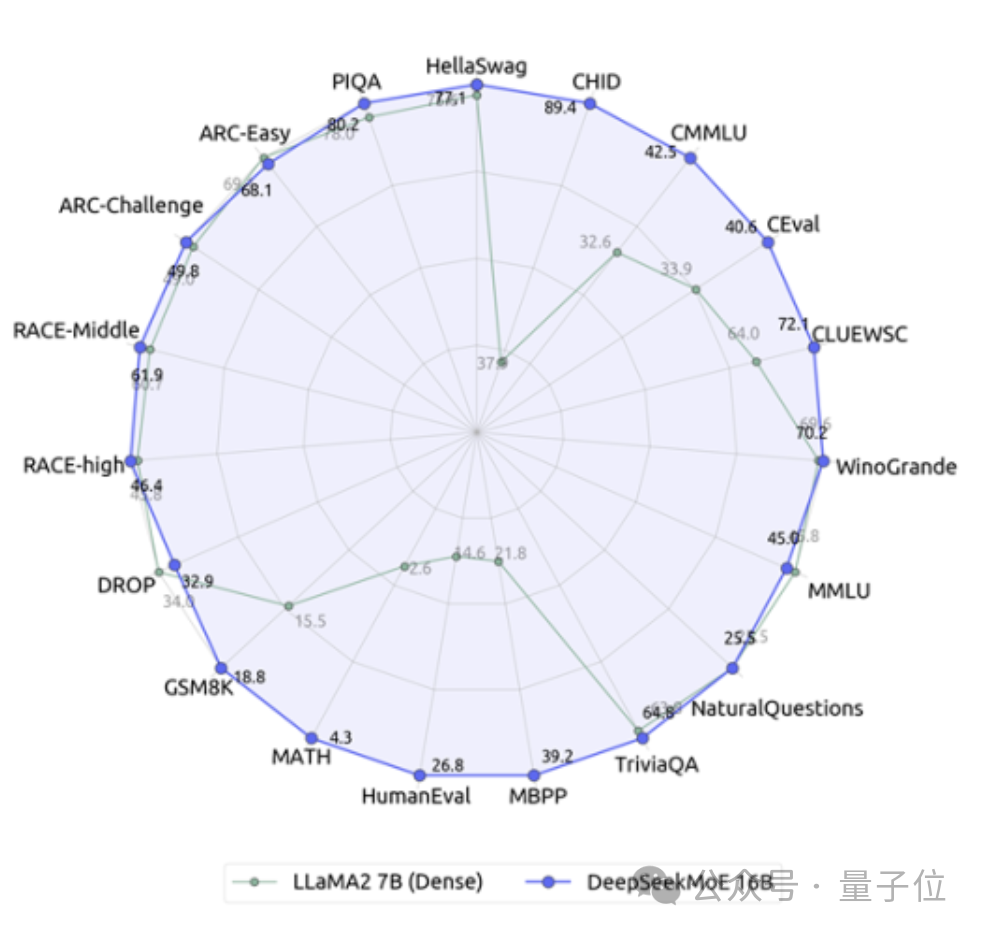
It is the Deep Search team’s latest open source 16 billion parameter expert model DeepSeek MoE.
In addition to its excellent performance, DeepSeek MoE's main focus is to save computing power.
In this performance-activation parameter diagram, it "singles out" and occupies a large blank area in the upper left corner.
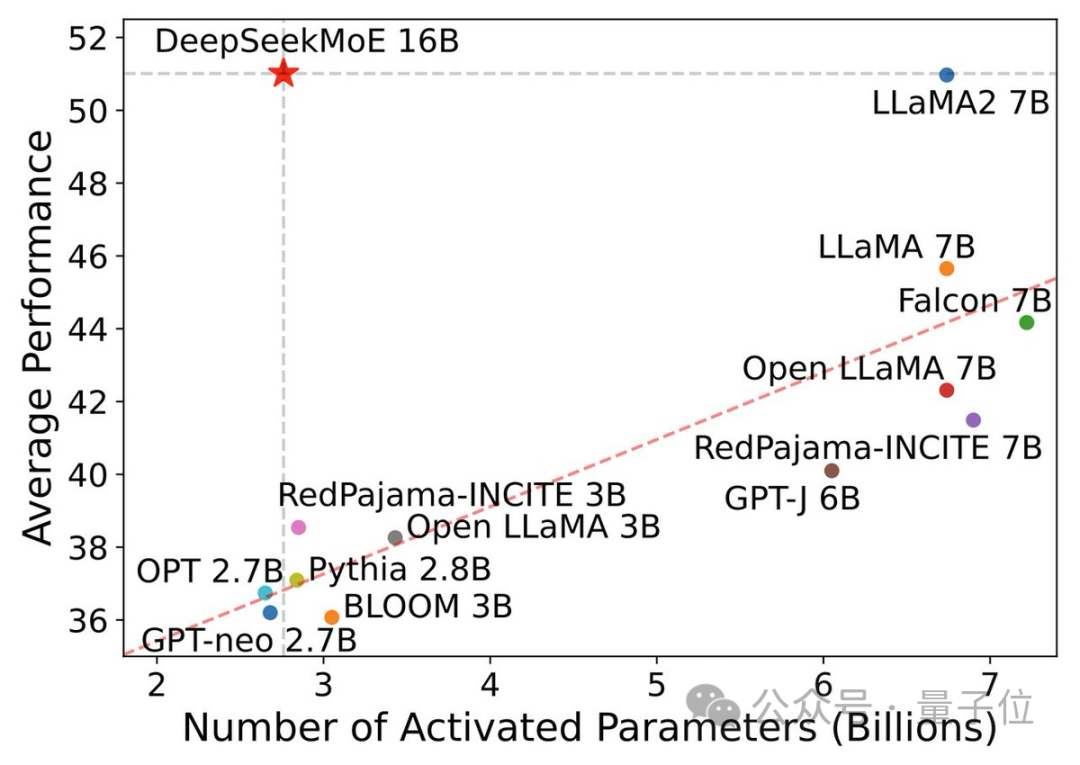
Only one day after its release, the DeepSeek team’s tweet on X received a large number of retweets and attention.
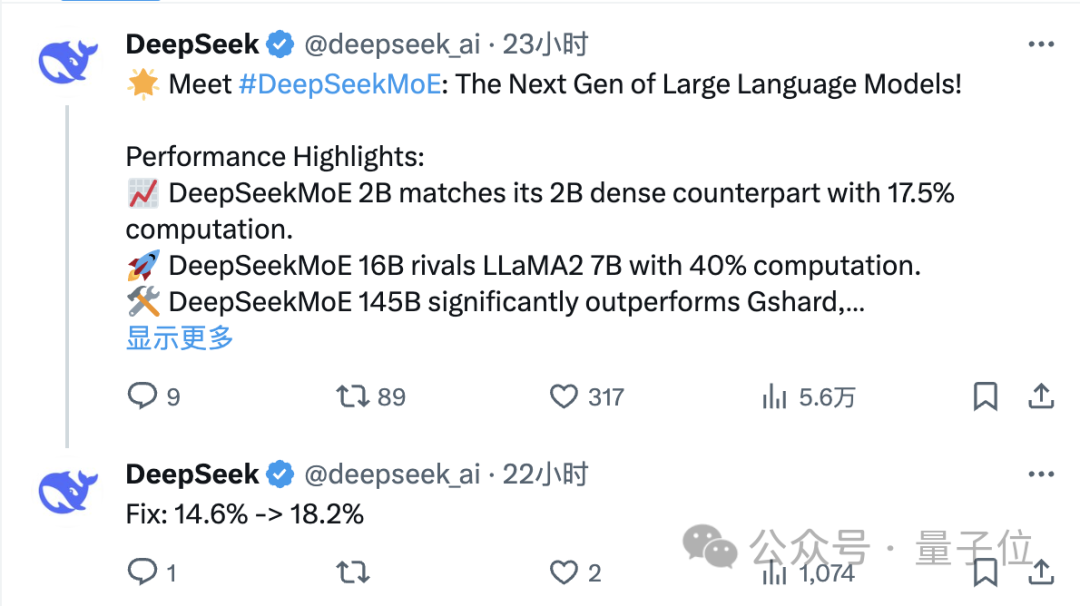
Maxime Labonne, a machine learning engineer at JP Morgan, also said after testing that the chat version of DeepSeek MoE performs slightly better than Microsoft's "small model" Phi-2.
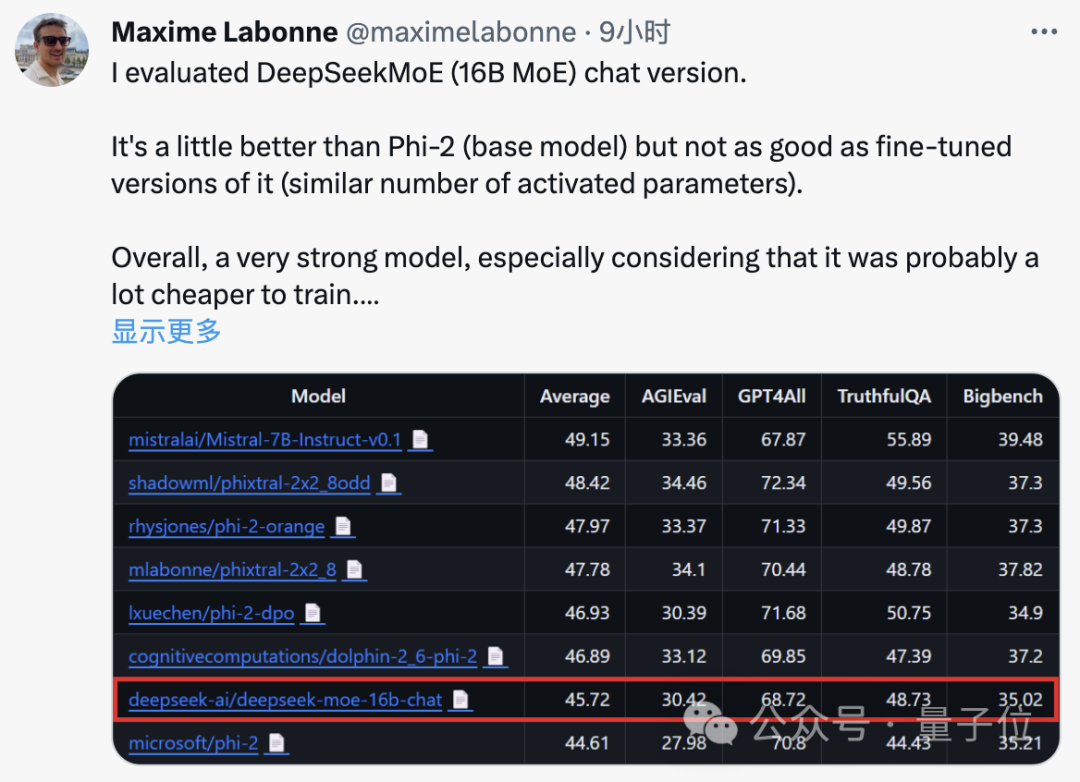
At the same time, DeepSeek MoE also received 300 stars on GitHub and appeared on the homepage of the Hugging Face text generation model rankings.

So, what is the specific performance of DeepSeek MoE?
The amount of calculation is reduced by 60%
The current version of DeepSeek MoE has 16 billion parameters, and the actual number of activated parameters is about 2.8 billion.
Compared with its own 7B dense model, the performance of the two on the 19 data sets has different advantages and disadvantages, but the overall performance is relatively close.
Compared with Llama 2-7B, which is also a dense model, DeepSeek MoE also shows obvious advantages in mathematics, code, etc.
But the calculation amount of both dense models exceeds 180TFLOPs per 4k tokens, while DeepSeek MoE only has 74.4TFLOPs, which is only 40% of the two.
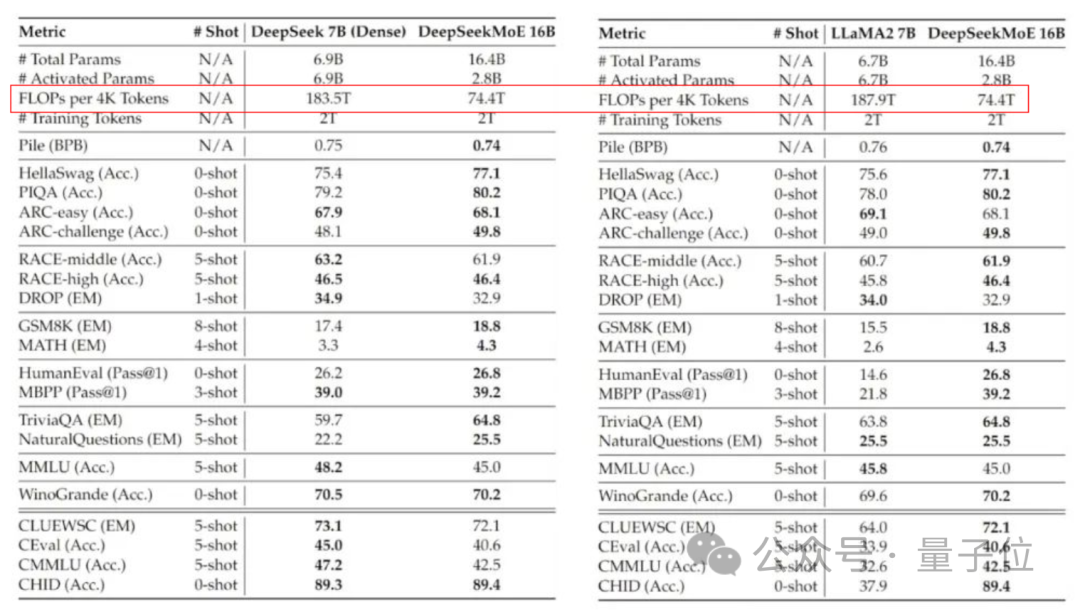
Performance tests conducted at 2 billion parameters show that DeepSeek MoE can also achieve the performance of the same MoE model with 1.5 times the number of parameters with less calculation. GShard 2.8B has comparable or even better results.

In addition, the Deep Seek team also fine-tuned the Chat version of DeepSeek MoE based on SFT, and its performance was also close to its own intensive version and Llama 2-7B.
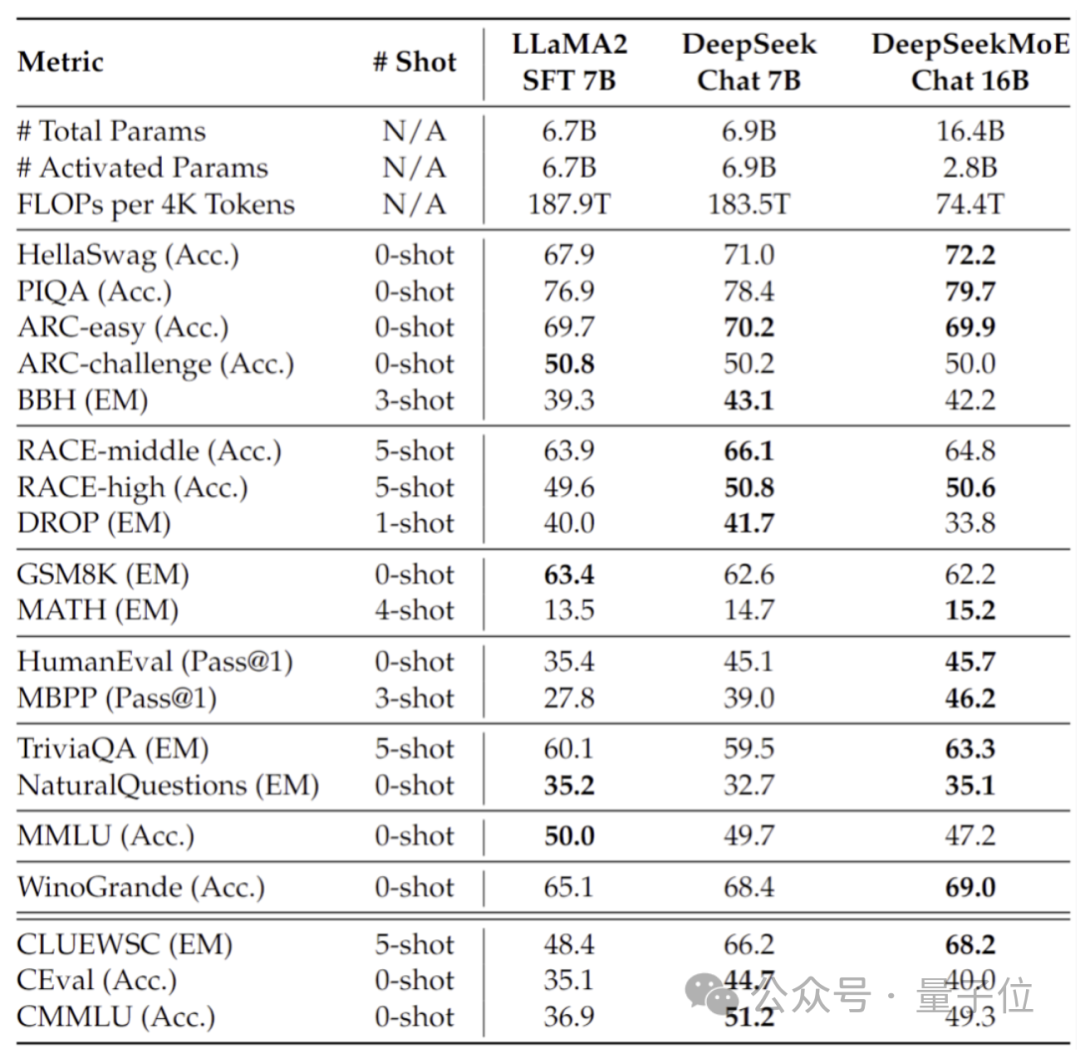
In addition, the DeepSeek team also revealed that a 145B version of the DeepSeek MoE model is under development.
Phased preliminary tests show that the 145B DeepSeek MoE has a huge lead over the GShard 137B, and can achieve equivalent performance to the dense version of the DeepSeek 67B model with 28.5% of the calculation amount.
After the research and development is completed, the team will also open source the 145B version.
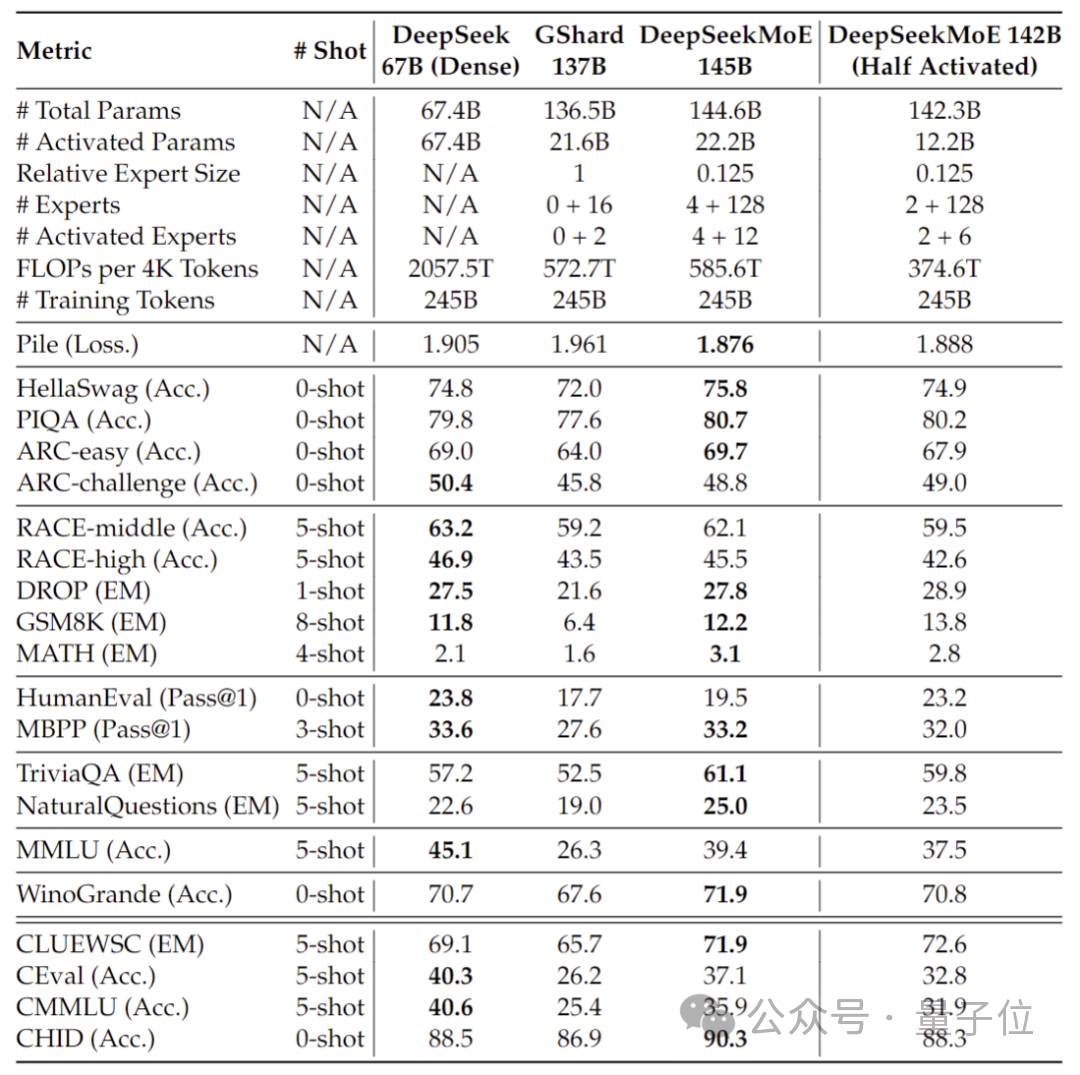
Behind the performance of these models is DeepSeek’s new self-developed MoE architecture.
Self-developed MoE new architecture
First of all, compared to the traditional MoE architecture, DeepSeek has a more fine-grained expert division.
When the total number of parameters is fixed, the traditional model can classify N experts, while DeepSeek may classify 2N experts.
At the same time, the number of experts selected each time a task is performed is twice that of the traditional model, so the overall number of parameters used remains the same, but the degree of freedom of selection increases.
This segmentation strategy allows for a more flexible and adaptive combination of activation experts, thereby improving the accuracy of the model on different tasks and the pertinence of knowledge acquisition.
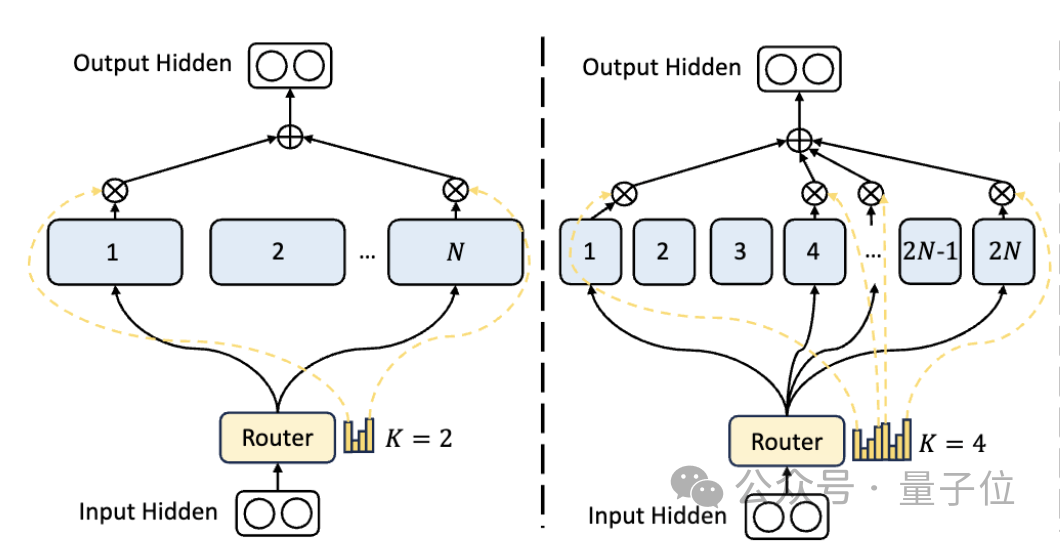
In addition to the differences in expert division, DeepSeek also innovatively introduces the "shared expert" setting.
These shared experts activate tokens for all inputs and are not affected by the routing module. The purpose is to capture and integrate common knowledge that is needed in different contexts.
By compressing these shared knowledge into shared experts, parameter redundancy among other experts can be reduced, thereby improving the parameter efficiency of the model.
The setting of shared experts helps other experts focus more on their unique knowledge areas, thereby improving the overall level of expert specialization.

#Ablation experiment results show that both solutions play an important role in the "cost reduction and efficiency increase" of DeepSeek MoE.
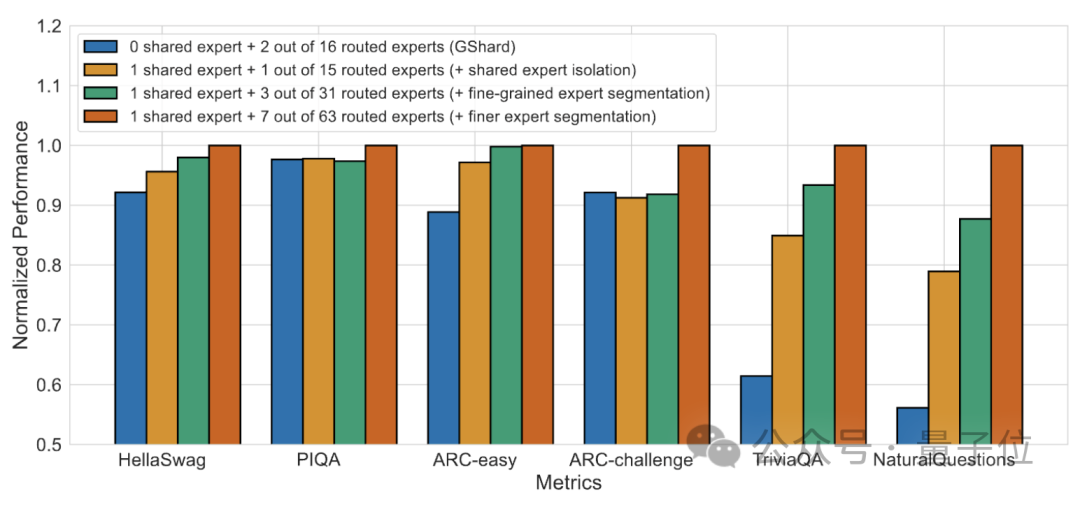
Paper address: https://arxiv.org/abs/2401.06066.
Reference link: https://mp.weixin.qq.com/s/T9-EGxYuHcGQgXArLXGbgg.
The above is the detailed content of Introducing a large domestic open source MoE model, its performance is comparable to Llama 2-7B, while the calculation amount is reduced by 60%. For more information, please follow other related articles on the PHP Chinese website!

Hot AI Tools

Undresser.AI Undress
AI-powered app for creating realistic nude photos

AI Clothes Remover
Online AI tool for removing clothes from photos.

Undress AI Tool
Undress images for free

Clothoff.io
AI clothes remover

Video Face Swap
Swap faces in any video effortlessly with our completely free AI face swap tool!

Hot Article

Hot Tools

Notepad++7.3.1
Easy-to-use and free code editor

SublimeText3 Chinese version
Chinese version, very easy to use

Zend Studio 13.0.1
Powerful PHP integrated development environment

Dreamweaver CS6
Visual web development tools

SublimeText3 Mac version
God-level code editing software (SublimeText3)

Hot Topics
 Bytedance Cutting launches SVIP super membership: 499 yuan for continuous annual subscription, providing a variety of AI functions
Jun 28, 2024 am 03:51 AM
Bytedance Cutting launches SVIP super membership: 499 yuan for continuous annual subscription, providing a variety of AI functions
Jun 28, 2024 am 03:51 AM
This site reported on June 27 that Jianying is a video editing software developed by FaceMeng Technology, a subsidiary of ByteDance. It relies on the Douyin platform and basically produces short video content for users of the platform. It is compatible with iOS, Android, and Windows. , MacOS and other operating systems. Jianying officially announced the upgrade of its membership system and launched a new SVIP, which includes a variety of AI black technologies, such as intelligent translation, intelligent highlighting, intelligent packaging, digital human synthesis, etc. In terms of price, the monthly fee for clipping SVIP is 79 yuan, the annual fee is 599 yuan (note on this site: equivalent to 49.9 yuan per month), the continuous monthly subscription is 59 yuan per month, and the continuous annual subscription is 499 yuan per year (equivalent to 41.6 yuan per month) . In addition, the cut official also stated that in order to improve the user experience, those who have subscribed to the original VIP
 Context-augmented AI coding assistant using Rag and Sem-Rag
Jun 10, 2024 am 11:08 AM
Context-augmented AI coding assistant using Rag and Sem-Rag
Jun 10, 2024 am 11:08 AM
Improve developer productivity, efficiency, and accuracy by incorporating retrieval-enhanced generation and semantic memory into AI coding assistants. Translated from EnhancingAICodingAssistantswithContextUsingRAGandSEM-RAG, author JanakiramMSV. While basic AI programming assistants are naturally helpful, they often fail to provide the most relevant and correct code suggestions because they rely on a general understanding of the software language and the most common patterns of writing software. The code generated by these coding assistants is suitable for solving the problems they are responsible for solving, but often does not conform to the coding standards, conventions and styles of the individual teams. This often results in suggestions that need to be modified or refined in order for the code to be accepted into the application
 Seven Cool GenAI & LLM Technical Interview Questions
Jun 07, 2024 am 10:06 AM
Seven Cool GenAI & LLM Technical Interview Questions
Jun 07, 2024 am 10:06 AM
To learn more about AIGC, please visit: 51CTOAI.x Community https://www.51cto.com/aigc/Translator|Jingyan Reviewer|Chonglou is different from the traditional question bank that can be seen everywhere on the Internet. These questions It requires thinking outside the box. Large Language Models (LLMs) are increasingly important in the fields of data science, generative artificial intelligence (GenAI), and artificial intelligence. These complex algorithms enhance human skills and drive efficiency and innovation in many industries, becoming the key for companies to remain competitive. LLM has a wide range of applications. It can be used in fields such as natural language processing, text generation, speech recognition and recommendation systems. By learning from large amounts of data, LLM is able to generate text
 Can fine-tuning really allow LLM to learn new things: introducing new knowledge may make the model produce more hallucinations
Jun 11, 2024 pm 03:57 PM
Can fine-tuning really allow LLM to learn new things: introducing new knowledge may make the model produce more hallucinations
Jun 11, 2024 pm 03:57 PM
Large Language Models (LLMs) are trained on huge text databases, where they acquire large amounts of real-world knowledge. This knowledge is embedded into their parameters and can then be used when needed. The knowledge of these models is "reified" at the end of training. At the end of pre-training, the model actually stops learning. Align or fine-tune the model to learn how to leverage this knowledge and respond more naturally to user questions. But sometimes model knowledge is not enough, and although the model can access external content through RAG, it is considered beneficial to adapt the model to new domains through fine-tuning. This fine-tuning is performed using input from human annotators or other LLM creations, where the model encounters additional real-world knowledge and integrates it
 Five schools of machine learning you don't know about
Jun 05, 2024 pm 08:51 PM
Five schools of machine learning you don't know about
Jun 05, 2024 pm 08:51 PM
Machine learning is an important branch of artificial intelligence that gives computers the ability to learn from data and improve their capabilities without being explicitly programmed. Machine learning has a wide range of applications in various fields, from image recognition and natural language processing to recommendation systems and fraud detection, and it is changing the way we live. There are many different methods and theories in the field of machine learning, among which the five most influential methods are called the "Five Schools of Machine Learning". The five major schools are the symbolic school, the connectionist school, the evolutionary school, the Bayesian school and the analogy school. 1. Symbolism, also known as symbolism, emphasizes the use of symbols for logical reasoning and expression of knowledge. This school of thought believes that learning is a process of reverse deduction, through existing
 To provide a new scientific and complex question answering benchmark and evaluation system for large models, UNSW, Argonne, University of Chicago and other institutions jointly launched the SciQAG framework
Jul 25, 2024 am 06:42 AM
To provide a new scientific and complex question answering benchmark and evaluation system for large models, UNSW, Argonne, University of Chicago and other institutions jointly launched the SciQAG framework
Jul 25, 2024 am 06:42 AM
Editor |ScienceAI Question Answering (QA) data set plays a vital role in promoting natural language processing (NLP) research. High-quality QA data sets can not only be used to fine-tune models, but also effectively evaluate the capabilities of large language models (LLM), especially the ability to understand and reason about scientific knowledge. Although there are currently many scientific QA data sets covering medicine, chemistry, biology and other fields, these data sets still have some shortcomings. First, the data form is relatively simple, most of which are multiple-choice questions. They are easy to evaluate, but limit the model's answer selection range and cannot fully test the model's ability to answer scientific questions. In contrast, open-ended Q&A
 SK Hynix will display new AI-related products on August 6: 12-layer HBM3E, 321-high NAND, etc.
Aug 01, 2024 pm 09:40 PM
SK Hynix will display new AI-related products on August 6: 12-layer HBM3E, 321-high NAND, etc.
Aug 01, 2024 pm 09:40 PM
According to news from this site on August 1, SK Hynix released a blog post today (August 1), announcing that it will attend the Global Semiconductor Memory Summit FMS2024 to be held in Santa Clara, California, USA from August 6 to 8, showcasing many new technologies. generation product. Introduction to the Future Memory and Storage Summit (FutureMemoryandStorage), formerly the Flash Memory Summit (FlashMemorySummit) mainly for NAND suppliers, in the context of increasing attention to artificial intelligence technology, this year was renamed the Future Memory and Storage Summit (FutureMemoryandStorage) to invite DRAM and storage vendors and many more players. New product SK hynix launched last year
 SOTA performance, Xiamen multi-modal protein-ligand affinity prediction AI method, combines molecular surface information for the first time
Jul 17, 2024 pm 06:37 PM
SOTA performance, Xiamen multi-modal protein-ligand affinity prediction AI method, combines molecular surface information for the first time
Jul 17, 2024 pm 06:37 PM
Editor | KX In the field of drug research and development, accurately and effectively predicting the binding affinity of proteins and ligands is crucial for drug screening and optimization. However, current studies do not take into account the important role of molecular surface information in protein-ligand interactions. Based on this, researchers from Xiamen University proposed a novel multi-modal feature extraction (MFE) framework, which for the first time combines information on protein surface, 3D structure and sequence, and uses a cross-attention mechanism to compare different modalities. feature alignment. Experimental results demonstrate that this method achieves state-of-the-art performance in predicting protein-ligand binding affinities. Furthermore, ablation studies demonstrate the effectiveness and necessity of protein surface information and multimodal feature alignment within this framework. Related research begins with "S





